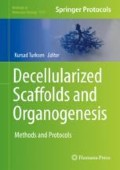Abstract
Scaffolds, both natural and synthetic, used in tissue engineering provide mechanical support to cells. Tissue decellularization has been used to provide natural extracellular matrix scaffolds for tissue engineering purposes. In this chapter we focus on describing the methodology used to decellularize Wharton’s jelly matrix, the mucous connective tissue that surrounds umbilical cord vessels, to obtain decellularized Wharton’s jelly matrix (DWJM); an extracellular matrix that can be used for tissue engineering purposes. We also, briefly, describe our experience with processing DWJM for cell seeding and recellularization.
References
Jadalannagari S, Converse G, McFall C, Buse E, Filla M, Villar MT, Artigues A, Mellot AJ, Wang J, Detamore MS, Hopkins RA, Aljitawi OS (2017) Decellularized Wharton’s Jelly from human umbilical cord as a novel 3D scaffolding material for tissue engineering applications. PLoS One 12(2):e0172098
Zippel N, Schulze M, Tobiasch E (2009) Biomaterials and Mesenchymal stem cells for regenerative medicine. Recent Pat Biotechnol. doi: BIOT-ABSTRACT 08 [pii]
Hellstrom M, El-Akouri RR, Sihlbom C, Olsson BM, Lengqvist J, Backdahl H, Johansson BR, Olausson M, Sumitran-Holgersson S, Brannstrom M (2014) Towards the development of a bioengineered uterus: comparison of different protocols for rat uterus decellularization. Acta Biomater 10(12):5034–5042
Costa F, Dohmen P, Vieira E, Lopes SV, Colatusso C, Pereira EWL, Matsuda CN, Cauduro S (2007) Ross operation with decellularized pulmonary allografts: medium-term results. Rev Bras Cir Cardiovasc 22(4):454–462
Kiyotake EA, Beck EC, Detamore MS (2016) Cartilage extracellular matrix as a biomaterial for cartilage regeneration. Ann N Y Acad Sci 1383(1):139–159
Law JX, Liau LL, Aminuddin BS, Ruszymah BHI (2016) Tissue-engineered trachea: a review. Int J Pediatr Otorhinolaryngol 91:55–63
Franc S, Rousseau JC, Garrone R, van der Rest M, Moradi-Ameli M (1998) Microfibrillar composition of umbilical cord matrix: characterization of fibrillin, collagen VI and intact collagen V. Placenta 19(1):95–104
Ferguson VL, Dodson RB (2009) Bioengineering aspects of the umbilical cord. Eur J Obstet Gynecol Reprod Biol 144(Suppl 1):S108–S113. doi: S0301-2115(09)00133-X [pii]10.1016/j.ejogrb.2009.02.024
Grayson WL, Zhao F, Izadpanah R, Bunnell B, Ma T (2006) Effects of hypoxia on human mesenchymal stem cell expansion and plasticity in 3D constructs. J Cell Physiol 207(2):331–339. doi:10.1002/jcp.20571
Bastow ER, Byers S, Golub SB, Clarkin CE, Pitsillides AA, Fosang AJ (2008) Hyaluronan synthesis and degradation in cartilage and bone. Cell Mol Life Sci 65(3):395–413. doi:10.1007/s00018-007-7360-z
Ishige I, Nagamura-Inoue T, Honda MJ, Harnprasopwat R, Kido M, Sugimoto M, Nakauchi H, Tojo A (2009) Comparison of mesenchymal stem cells derived from arterial, venous, and Wharton’s Jelly explants of human umbilical cord. Int J Hematol 90(2):261–269. doi:10.1007/s12185-009-0377-3
Sobolewski K, Malkowski A, Bankowski E, Jaworski S (2005) Wharton’s Jelly as a reservoir of peptide growth factors. Placenta 26(10):747–752. doi:S0143-4004(04)00260-7 [pii] 10.1016/j.placenta.2004.10.008
Taipale J, Keski-Oja J (1997) Growth factors in the extracellular matrix. FASEB J 11(1):51–59
Author information
Authors and Affiliations
Corresponding author
Editor information
Editors and Affiliations
Rights and permissions
Copyright information
© 2017 Springer Science+Business Media New York
About this protocol
Cite this protocol
Converse, G.L., Li, D., Buse, E.E., Hopkins, R.A., Aljitawi, O.S. (2017). Wharton’s Jelly Matrix Decellularization for Tissue Engineering Applications. In: Turksen, K. (eds) Decellularized Scaffolds and Organogenesis. Methods in Molecular Biology, vol 1577. Humana Press, New York, NY. https://doi.org/10.1007/7651_2017_61
Download citation
DOI: https://doi.org/10.1007/7651_2017_61
Published:
Publisher Name: Humana Press, New York, NY
Print ISBN: 978-1-4939-7655-3
Online ISBN: 978-1-4939-7656-0
eBook Packages: Springer Protocols

